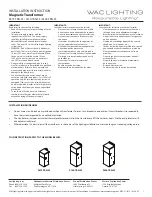
TK-373G
6
OPERATING FEATURES
PTT button is held down. The alert tone stops when the PTT
button is released.
2) PTT ID
PTT ID provides a DTMF ANI to be sent with the PTT button
every time it is used (Begin of TX ID at beginning of
transmission, End of TX ID at end of transmission, or both).
You can program the PTT ID as one of the followings.
Off, BOT (Begin of TX ID), EOT (End of PTT ID), BOTH.
You can program PTT ID “on” or “off” for each group.
The transceiver is capable of having ID. The format is DTMF.
The timing that the transceiver sends the ID is
programmable.
Begin of TX ID (BOT) : Begin of TX ID is sent at the
beginning of transmission.
End of TX ID (EOT) : End of TX ID is sent at the end of
transmission.
Both : Begin of TX ID is sent at the beginning of transmission
and End of TX ID is sent at the end of transmission.
There is also a "PTT ID" setting for each group.
3) Battery Warning
This transceiver has a battery warning feature. If low voltage
is detected during transmission, the transceiver warns you by
a flashing red "LED".
When the voltage is detected to be even lower during
transmission, the transceiver stops transmission and warns
you by a flashing red "LED" and a beep.
Please notice "indication" for the battery exchange, charging
time by flashing red LED and beep.
4) Radio password
When the password is set in the transceiver, user can not
use the transceiver unless enter the correct password.
This code can be up to 6 digits from 0 to 9 and input with
the keypad or selector, and “A” key.
5) Call indicator
The call indicator can be programmed for each group. In
trunked system, it can be set to respond to a selectable decode
ID or one of two fixed IDs, except block IDs. When a call is
received with a selectable decode ID, the call indicator flashes.
When a call is received with a fixed ID, the call indicator lights
continuously.
On a conventional system, the call indicator can be
programmed to light for each QT or DQT code. It keeps flashing
while a call is being received. It is turned off by pressing any
front panel key.
6) Free system ringback
This feature is available only when a telephone
interconnected ID code is selected. If a busy tone sounds when
the PTT button is pressed, the transceiver enters this mode
automatically.
When the PTT button is released, a beep sounds for 400ms
to indicate that the mode has been entered. If the scan is on, it
is resumed (the “SCN” mark goes on). When any repeater
becomes available, a ringing tone sounds and this mode ends.
The mode is terminated when the system, group, scan, PTT,
key is changed.
7) System search
This feature can be programmed to automatically access
other programmed systems when the selected system cannot
be accessed. If an intercept tone sounds when the PTT button
is pressed after setting the mode, the transceiver has entered
the mode.
If the group ID is a telephone interconnect ID, the transceiver
then attempts to access, in succession, other systems that
have a telephone interconnect ID in the revert group location.
If the group ID is a dispatch ID, the transceiver attempts to
access other systems that have a dispatch ID programmed in
the revert group location.
If there is no system to be accessed, an intercept tone
sounds, the mode is terminated, and the transceiver returns to
the first system. If the access is successful, the mode is
terminated, and the searched system becomes the new
selected system (If during scanning, the scan stops).
8) Transpond
This feature can be programmed to turn on and off for each
group. If the ID of the group for which transpond is enabled is
received, two data messages (transmit ID and turn-off code)
are automatically transmitted if the PTT button is not pressed
as a response within the time set (0 to 300 seconds in 1-second
increments). If the PTT button is pressed within the time, the
transpond is not preformed.
9) Transmit inhibit
The transceiver can be programmed with a transmit inhibit
block of ID codes. If an ID code within this block is decoded
the preset time before the PTT button is pressed, transmission
is inhibited. The BUSY indicator lights and a busy tone sounds
until the PTT button is released to indicate that transmission is
not possible (except clear-to talk mode).
Transmission with the group for which the encode ID is not
set is inhibited, and the busy tone is output while the PTT button
is held down, regardless of the clear-to -talk setting.
5. Audible user feedback tones
The transceiver outputs various combinations of tones to
notify the user of the transceiver operating state. The main
tones are listed below
The high tone is 1477Hz, the mid tone is 941Hz, and the
low tone is 770Hz.
• Power on tone
This tone is output when the transceiver is turned on. (The
high tone is output for 500ms.)







































